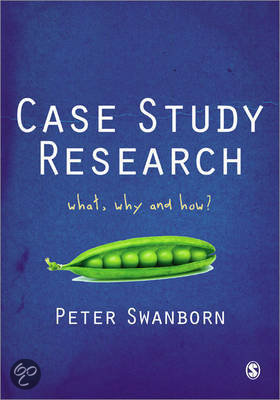Hoofdstuk 1: What is a case study?
Case: a case concerns a specific instance or manifestation of the phenomenon to be
studied. It may involve only one actor, sometimes many interaction actors.
Single-case study: a case study based on one case
Multiple-case study: a case study based on several cases
Three conditions can be distinguished depending on the level of inquiry:
1. Micro-level: in health sciences, psychology and psychotherapy, a strong tradition
exists of N=1 studies, aiming at the healing of this patient or helping this client. Most
of them are disciplined in the striving for comparable data and in the general goal of
understanding an illness and finding an adequate treatment,
2. Meso-level: disciplines such as sociology, anthropology, history, the administrative
and organizational sciences, education and many others use the label ‘case studies’
in research with an emphasis on detailed description and an understanding and
explanation of a social process or phenomenon
3. Macro-level: the political sciences and parts of economy apply the label ‘case
studies’ mostly to those research projects that try to uncover relationships between
causes and effects using a small number of units, mostly nation-states
Case study: the study of a social phenomenon
In one, or only a few, of its manifestations
In its natural surroundings
During a certain period
That focuses on detailed descriptions, interpretations and explanations that several
categories of participants in the system attach to the social process
In which the researcher starts with a broad research question on an ongoing social
process and uses available theories, but abstrains from pre-fixed procedures of data
collection and data analysis, and always keeps an eye open to the newly gathered
data in order to flexibly adjust subsequent research steps
That exploits several sources of data (informants, documents, observatory notes)
In which sometimes the participants in the studied case are engaged in a process of
confrontation with the explanations, views and behaviors of other participants and
with the resulting preliminary results of the researcher
Hoofdstuk 2: When to conduct a case study?
Selection of the case study as a research strategy is primarily guided by the character of the
RESEARCH QUESTION.
If it concerns descriptive and/or explanatory broad questions about a social process in a
situation in which we have little knowledge of the phenomenon, and specifically, if we are
interested in the ways several individuals and groups of stakeholders interact with each
others and interpret each other’s behavior, and the ways in which they cope with problems,
, we need to explore one or more cases to clarify the intricate web of social relations,
perceptions, opinions, attitudes and behavior. Besides, case studies as a main research
strategy are selected under one or more of the following set of conditions:
The impossibility to isolate or simulate (properties that are relevant to) the
phenomenon
The rarity of the phenomenon
Design problems
The intention to combine research and action.
Some general background questions have to be posed and answered:
Are we dealing with an autonomous case study, or is the planned case study part of a
complex of strategies to tackle the same object? If the latter is the case, how does
the case study fit in with respect to the other strategies?
Are we dealing with basic research or with applied research?
Do the cases to be selected figure as pars pro toto (delen van een geheel) or as
stand-alone cases? Often we want to generalize to a larger set of cases, but
sometimes we are only interested in the specific cases under study. In this context,
the demarcation of the phenomenon to be studied as well as of the units or cases,
the bearers of the phenomenon, is of primary significance.
Several non-relational factors may also be involved in selecting a research strategy:
Some consider the case study as the one and only strategy in social science. They
tend to ignore the fact that many research questions, for instance those with respect
to frequency distributions, simply cannot be answered as almost completely
dependent on their own subjective priorities and preferences.
Some say that the case study selected them, rather than the other way around.
Indeed, some students do have an inborn preference for large-scale surveys, others
for intensive field studies within one social system. Actually, in such cases the
researcher’s personal preferences precede formulating the research questions. One
cannot object to this state of affairs as long as a relevant research question is posed
and the research strategy is an adequate choice. But, in the harsh reality of social
research, many exceptions to this rule exist.
There are also those who regard the case study as only a second-best choice, when
for practical reasons other preferred strategies are excluded
Thus, rational arguments do not always dictate the choice of a strategy.
There is one more factor that may affect the choice of a research strategy the perceived
difficulty of a strategy.
Generally, case studies are perceived as easier to bring to a good ending than, for
instance, experiments or a survey
However, this idea is wrong: exactly because there is no fixed procedure to follow,
and because the ‘social sensitivity’ of the researcher as well as creativity and
methodological sophistication play a major role, a case study is more difficult to
perform than following a strategy of several phases, each phase more or less
dictated by ‘how to do’ handbooks. Flexibility and a potential for quick learning in
the field are the necessary characteristics of the case study researcher.






